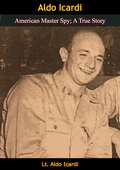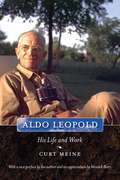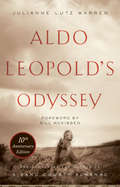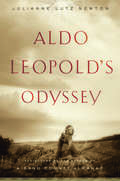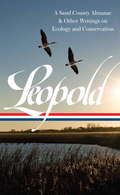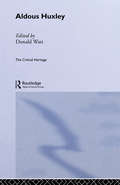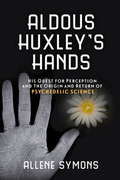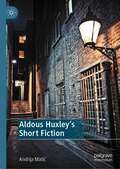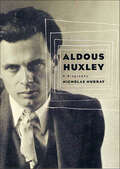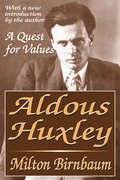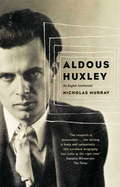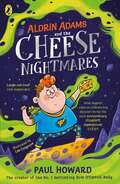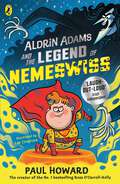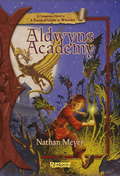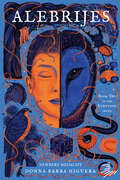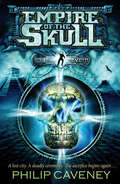- Table View
- List View
Aldi: The Dark Horse Discounter
by David Lane Eric J. Van Den SteenIn 2013, Aldi—the world's 8th largest retailer—planned to accelerate its US expansion. Aldi was a German-based hard discounter that sold a limited assortment of private-label groceries and household items in barebones stores. Despite its presence with 1200 stores in 32 states, Aldi was still relatively unknown in the US. But it was often cited as one of the reasons for Walmart's exit from Germany. Could it compete with Walmart in the US, Walmart's home market?
Aldo Applesauce
by Johanna HurwitzWhen he and his family move to the suburbs, Aldo has difficulty finding new friends.
Aldo Icardi: American Master Spy; A True Story
by Lt. Aldo IcardiAldo Icardi (1921-2011) was a U.S. Army second lieutenant during World War II who was sent as a specially-trained soldier by the U.S. Army’s Office of Strategic Services (OSS) on a special mission into enemy-occupied territory in Italy to organize resistance movements. During this mission, which was code-named “Chrysler,” its commander Major John William V. Holohan disappeared, and Lt. Icardi, along with radio operator Carl G. LoDolce and three Italians, was charged with his murder. The Italians, who spent three years in jail, were later acquitted, and Icardi and LoDolce were convicted in absentia of murder and sentenced to life and 17 years respectively, but neither man could be extradited back to Italy, so did not serve time. In 1955, Icardi was indicted by a federal grand jury for perjury, but was acquitted in 1956. The Italian Communist commander Vincenzo Moscatelli later admitted that he was responsible for Major Holohan’s death and that Icardi had nothing to do with it.With this book, which was first published in 1954, Aldo Icardi seeks to set the record straight on all the newspaper stories that circulated in the wake of the killing, and ever since.A gripping true-life story.“This book is the true story, as well as I know it, of what actually happened to Major Holohan. It is my defense against the charges of murder. And it is the story of the most dangerous and exciting eight months I have ever lived.”—Aldo Icardi
Aldo Ice Cream
by Johanna Hurwitz[From the back cover:] "A grubby sneaker contest, traveling cats, and a hurricane... . It's not quite the summer that Aldo had planned. When Aldo's mother asks him to help her deliver Meals On Wheels to the elderly and housebound, Aldo's summer vacation soon becomes very busy. How can he get Mr. Puccini to talk? Would a visit from his cat help cheer up Mrs. Nardi? And how can he earn enough money to buy an ice-cream freezer for his sister's birthday? Aldo is determined to solve these questions (and several others)... even if it takes him all summer to do it." Pictures are described. You'll find more books about Aldo, a curious, thoughtful boy with lots of energy in the Bookshare collection. Look for Aldo Applesauce, Aldo Peanut Butter, and Much Ado About Aldo
Aldo Leopold
by Curt MeineThis biography of Aldo Leopold follows him from his childhood as a precocious naturalist to his profoundly influential role in the development of conservation and modern environmentalism in the United States. This edition includes a new preface by author Curt Meine and an appreciation by acclaimed Kentucky writer and farmer Wendell Berry.
Aldo Leopold's Odyssey, Tenth Anniversary Edition: Rediscovering the Author of A Sand County Almanac
by Julianne Lutz WarrenIn 2006, Julianne Lutz Warren(néeNewton) asked readers to rediscover one of history's most renowned conservationists. Aldo Leopold's Odyssey was hailed by The New York Times as a "biography of ideas," making "us feel the loss of what might have followed A Sand County Almanac by showing us in authoritative detail what led up to it. " Warren's astute narrative quickly became an essential part of the Leopold canon, introducing new readers to the father of wildlife ecology and offering a fresh perspective to even the most seasoned scholars. A decade later, as our very concept of wilderness is changing, Warren frames Leopold's work in the context of the Anthropocene. With a new preface and foreword by Bill McKibben, the book underscores the ever-growing importance of Leopold's ideas in an increasingly human-dominated landscape. Drawing on unpublished archives, Warren traces Leopold's quest to define and preserve land health. Leopold's journey took him from Iowa to Yale to the Southwest to Wisconsin, with fascinating stops along the way to probe the causes of early land settlement failures, contribute to the emerging science of ecology, and craft a new vision for land use. Leopold's life was dedicated to one fundamental dilemma: how can people live prosperously on the land and keep it healthy, too? For anyone compelled by this question, the Tenth Anniversary Edition of Aldo Leopold's Odyssey offers insight and inspiration.
Aldo Leopold's Odyssey: Rediscovering the Author of A Sand County Almanac
by Julianne Lutz NewtonA household icon of the environmental movement, Aldo Leopold (1887-1948) may be the most quoted conservationist in history. A Sand County Almanac has sold millions of copies and Leopold's writings are venerated for their perceptions about land and how people might live in concert with the whole community of life. But who is the man behind the words? How did he arrive at his profound and poetic insights, inspiring generations of environmentalists? Building on past scholarship and a fresh study of Leopold's unpublished archival materials, Julianne Lutz Newton retraces the intellectual journey generated by such passion and intelligence. Aldo Leopold's Odyssey illuminates his lifelong quest for answers to a fundamental issue: how can people live prosperously on the land and keep it healthy, too? Leopold's journey took him from Iowa to Yale to the Southwest to Wisconsin, with fascinating stops along the way to probe the causes of early land settlement failures, contribute to the emerging science of ecology, and craft a new vision for land use. More than a biography, this articulate volume is a guide to one man's intellectual growth, and an inspirational resource for anyone pondering the relationships between people and the land.
Aldo Leopold: A Sand County Almanac & Other Writings on Conservation and Ecology
by Aldo Leopold Curt MeineSince his death in 1948, Aldo Leopold has been increasingly recognized as one of the indispensable figures of American environmentalism. A pioneering forester, sportsman, wildlife manager, and ecologist, he was also a gifted writer whose farsighted land ethic is proving increasingly relevant in our own time. Now, Leopold's essential contributions to our literature--some hard-to-find or previously unpublished--are gathered in a single volume for the first time. Here is his classic A Sand County Almanac, hailed--with Thoreau's Walden and Carson's Silent Spring--as one of the main literary influences on the modern environmental movement. Published in 1949, it is still astonishing today: a vivid, firsthand, philosophical tour de force. Along with Sand County are more than fifty articles, essays, and lectures exploring the new complexities of ecological science and what we would now call environmental ethics. Leopold's sharp-eyed, often humorous journals are illustrated here for the first time with his original photographs, drawings, and maps. Also unique to this collection is a selection of over 100 letters, most of them never before published, tracing his personal and professional evolution and his efforts to foster in others the love and sense of responsibility he felt for the land.
Aldo Peanut Butter
by Johanna Hurwitz Diane Degroat[From the front dust jacket flap] Aldo was hoping to get a puppy for his birthday. He got five! And even though he has to give three of them away, the stage is set for one howl of a summer--especially when Mom and Dad have to leave Aldo and his sisters in charge of the house for two weeks in July. Aldo is desperately trying to housebreak the two remaining puppies--Peanut and Butter--before they break everything in the house. It doesn't help that his crabby neighbor, Mrs. Crosby, is accusing the pups of digging up her front yard. And Aldo's sisters also have their hands full when Elaine's hair turns as green as the live lobsters that Karen has brought home for dinner. What will Mom and Dad say if they return to find that everything's gone to the dogs? Welcome back Aldo and his family and friends in Johanna Hurwitz's latest and funniest look at growing up. Bookshare has over twenty more enjoyable books by Johanna Hurwitz in the Bookshare collection including Aldo Ice Cream.
Aldo's Admissions
by Aldo CasilliHow do you say "see you later" to your wife without bursting into tears moments before open heart surgery, knowing full well that this may be the last goodbye? How do you maintain positivity while getting hit again and again with bad news? One day before his wife's 43rd birthday, Aldo was diagnosed with colon cancer which required major surgery to rectify. One week later, he incidentally discovered that he also had some very dangerous heart issues. Aldo had a leaking aortic valve which needed replacing and a 6.7 cm ascending aortic aneurysm which needed repairing, via open heart surgery. He was immediately told to cease all strenuous activity, including his work. Aldo's Admissions tells the story of Aldo's experiences and personal thoughts over a ten-month time span while dealing with all the upsetting news he receives and his fight to stay alive. This book is for anybody who wonders how it feels to be told you have serious health issues which suddenly put your existence on this planet under threat. It is also for anybody who is seeking reassurance to continue fighting these issues. Please sit down, put on your seat belts and enjoy the roller coaster ride. This is Aldo's journey.
Aldo's Fantastical Movie Palace
by Jonathan FriesenIn the Darkness of this Theater, Anything Can Happen The family's broken-down theater has always been a safe place for Chloe. There, no one can see the scars that line her face—scars her inventor father accidentally caused, leaving even deeper wounds between them. In the darkness she meets Nick, a boy with his own hurts. While Nick isn't the most pleasant companion, a rocky friendship is formed over their love of films. Soon the two are working on a movie script about a fantastical world—one that suddenly comes alive on the screen. Chloe and Nick are transported into an adventure beyond what they ever imagined, filled with dragons, magical pools, and a sinister vapor that threatens to destroy everyone. But when tragedy strikes, Chloe must find the courage to step out of the shadows and find what she’s always longed for.
Aldous Huxley
by Donald WattThis set comprises forty volumes covering nineteenth and twentieth century European and American authors. These volumes will be available as a complete set, mini boxed sets (by theme) or as individual volumes. This second set compliments the first sixty-eight volume set of Critical Heritage published by Routledge in October 1995.
Aldous Huxley
by Guinevera A. NanceCriticism and interpretation of Aldous Huxley's works, as well as an overview of his life.
Aldous Huxley's Hands
by Allene SymonsPsychedelics, neuroscience, and historical biography come together when a journalist finds a lost photograph of Aldous Huxley and uncovers a hidden side of the celebrated author of Brave New World and The Doors of Perception. Allene Symons had no inkling that Aldous Huxley was once a friend of her father's until the summer of 2001 when she discovered a box of her dad's old photographs. For years in the 1940s and '50s, her father had meticulously photographed human hands in the hope of developing a science of predicting human aptitudes and even mental illness. In the box, along with all the other hand images, was one with the name of Aldous Huxley on the back. How was it possible for two such unlikely people to cross paths--her aircraft-engineer father and the famous author?This question sparked a journalist's quest to understand what clearly seemed to be a little-known interest of Aldous Huxley. Through interviews, road trips, and family documents, the author reconstructs a time peaking in mid-1950s Los Angeles when Huxley experimented with psychedelic substances, ran afoul of gatekeepers, and advocated responsible use of such hallucinogens to treat mental illness as well as to achieve states of mind called mystical. Because the author's father had studied hundreds of hands, including those of schizophrenics, he was invited into Huxley's research and discussion circle. This intriguing narrative about the early psychedelic era throws new light on one of the 20th-century's foremost intellectuals, showing that his experiments in consciousness presaged pivotal scientific research underway today.From the Trade Paperback edition.
Aldous Huxley's Short Fiction
by Andrija MatićAldous Huxley’s Short Fiction analyzes Huxley’s short stories within a modernist context, highlighting that he shared more characteristics with distinguished modernists than is usually believed. The book also explores other features of Huxley’s short stories, focusing on themes such as consumerism, mainstream education, shallow intellectualism, women’s emancipation, toxic masculinity, and sensational journalism, themes that correspond with both Huxley’s time and our world, and position him among the most prophetic authors of the twentieth century. This study demonstrates that Huxley’s short fiction can provide answers to questions that remain confusing or partially explained in the research on Huxley’s work. It illustrates the constants and changes in Huxley’s opinions on organized religion, mysticism, and the relation between sexuality and spirituality, while also clarifying Huxley’s political opinion, which is often misunderstood due to his advocacy of pacifism. Finally, the in-depth interpretations of Huxley’s short stories reveal the dynamics of his literary style, especially his complex humor and irony, areas he developed more than any other modernist author of short fiction.
Aldous Huxley: A Biography
by Nicholas MurrayWhen Aldous Huxley died on November 22, 1963, on the same day that John F. Kennedy was assassinated, he was widely considered to be one of the most intelligent and wide-ranging English writers of the twentieth century. Associated in the public mind with his dystopian satire, Brave New World, and experimentation with drugs that preceded the psychedelic, a term he invented, era of the 1960s, Huxley seemed to embody the condition of twentieth-century man in his restless curiosity, his search for meaning in a post-religious age, and his concern about the misuses of science and the future of the planet.But Huxley was born when Queen Victoria was on the British throne. He was the grandson of the great Victorian scientist Thomas Henry Huxley "Darwin's bulldog," and the great-nephew of the great poet and critic Matthew Arnold. Exiled in the Californian sun, he never ceased to think of himself as part of a tradition that could be traced back to the Victorian public intellectuals. This biography of Huxley---the first in thirty years---draws on a substantial amount of unpublished material, as well as numerous interviews with his family and friends. It is a portrait of a daring and iconoclastic novelist; a man hampered by semi-blindness, who spent a restless life in search of personal enlightenment. Nicholas Murray charts Huxley's Bloomsbury years, his surprising and complex relationship with D. H. Lawrence, and his emigration to America in the late 1930s, where he pursued a career as a screenwriter while continuing his fascination with mysticism and religion. Huxley's private life was also unconventional, and this book reveals for the first time the extraordinary story of the ménage à trois including Huxley, his remarkable wife, Maria, and the Bloomsbury socialite and mistress of Clive Bell, Mary Hutchinson.Huxley emerges from this new biography as one of the most intriguing and complex figures of twentieth-century English writing---novelist, poet, biographer, philosopher, social and political thinker. In an era of intense specialization he remained a free-ranging thinker, unconfined by conventional categories, concerned to communicate his insights in ordinary language---a very English intellectual.
Aldous Huxley: A Quest for Values
by Milton BirnbaumIn the moral vacuum and world of shifting values following World War I, Aldous Huxley was both a sensitive refl ector and an articulate catalyst. This work provides a highly illuminating analysis of Huxley's evolution from skeptic to mystic. As Milton Birnbaum shows, in a perceptive interpretation of Huxley's poetry, fi ction, essays and biographies-what evolved in Huxley's moral and intellectual pilgrimage was not so much a change in direction as a shift in emphasis. Even in the sardonic Huxley of the 1920s and 1930s, there is a moral concern. In the later Huxley, there are traces of the satirical skepticism which delighted his readers in the decades preceding World War II. A man of letters, a keen observer, seeker of new ways while profoundly knowledgeable in the truths of ancient wisdom, Huxley tried to achieve a symbiotic synthesis of the best of all worlds. In clarifying and interpreting Huxley's intellectual, moral, and philosophical development, Birnbaum touches upon all the subjects that came under the scrutiny of a singularly encyclopedic mind. This book is of great worth to those interested both in Huxley the brilliant satirist and in Huxley the seeker of salvation. In his search, Huxley typifi ed the modern quest for values. Milton Birnbaum's study is an invaluable guide in that journey. His new introduction takes account of research and analysis of Huxley that has occurred since this book's original publication.
Aldous Huxley: An English Intellectual
by Nicholas MurrayThe grandson of biologist T. H. Huxley, Aldous Huxley had a privileged background and was educated at Eton and Oxford despite an eye infection that left him nearly blind. Having learned braille his eyesight then improved enough for him to start writing, and by the 1920s he had become a fashionable figure, producing witty and daring novels like CROME YELLOW (1921), ANTIC HAY (1923) and POINT COUNTER POINT (1928). But it is as the author of his celebrated portrayal of a nightmare future society, BRAVE NEW WORLD (1932), that Huxley is remembered today. A truly visionary book, it was a watershed in Huxley's world-view as his later work became more and more optimistic - coinciding with his move to California and experimentation with mysticism and psychedelic drugs later in life. Nicholas Murray's brilliant new book has the greatest virtue of literary biographies: it makes you want to go out and read its subject's work all over again. A fascinating reassessment of one of the most interesting writers of the twentieth century.
Aldrich Capital Partners
by Jo Tango Alys FerragamoBy July 2016, the Aldrich Capital Partners team had spent over two years trying to raise their inaugural growth-equity fund. They had pitched to over 140 investors, but none had committed. Managing Partners Mirza Baig and Raz Zia each had extensive experience in the growth-equity space, but they did not have an investment track record together. Investors seemed hesitant to commit to a "blind pool" of capital with a new team. Now, the partners were contemplating an investment in a company code-named "Hollywood." The deal had several risks and was not a perfect fit with their investment thesis, but the partners wondered if this deal could prove their abilities and strategy to investors. Should Aldrich invest in Hollywood?
Aldrin Adams and the Cheese Nightmares (Aldrin Adams Adventure #1)
by Paul Howard*Shortlisted for the Children's Book of the Year - Irish Book Awards*The laugh-out-loud funny children's book from Number-One-Bestselling Ross O'Carroll Kelly author, Paul Howard. Illustrated throughout by Lee Cosgrove.An adventure full of mystery, magic and cheeses that seriously, SERIOUSLY pong!ALDRIN ADAMS is an ordinary boy with an EXTRAORDINARY SUPERPOWER. When he eats cheese just before he goes to sleep, he can enter into other people's dreams . . . AND THEIR NIGHTMARES!But why has he got this power? And what is he supposed to do with it?HE NEEDS ANSWERS . . . AND FAST!What Aldrin doesn't realize is that he is being watched by a MYSTERIOUS, SUPERNATURAL VILLAIN who's creating nightmares for millions of children every night.Will an ordinary boy, armed with his pet frog and the STINKIEST CHEESE in the world, be enough to stop him?A brilliantly funny, heartwarming story, perfect for fans of David Baddiel and Sam Copeland.
Aldrin Adams and the Legend of Nemeswiss (Aldrin Adams Adventure #2)
by Paul HowardAn ordinary boy. The most EXTRAORDINARY, stinkiest superpower!Some months have past since Aldrin Adams discovered his extraordinary SUPERPOWER. When he eats CHEESE, just before he goes to sleep, he can enter into other people's dreams . . . and their nightmares! He's learned when to eat blue cheese (to help with nightmares about KILLER toys), smoked cheese (to help him recover from using his powers) and good old Cheddar (TOP SECRET). He's also come face to face with his nemesis - A MYSTERIOUS SUPERNATURAL VILLAIN who creates NIGHTMARES for millions of children every night.Aldrin survived, but only JUST. And now what is he supposed to do? Save the world, one SCARY CLOWN nightmare at a time? Shouldn't being a superhero be more adventurous than this? Is there a way to beat his Nemesis once and for all?Find out, as Aldrin navigates his new life, meets more people with powers like him and - finally - faces his NEMESIS again!
Aldwyn's Academy: A Companion Novel to a Practical Guide to Wizardry
by Nathan MeyerEnter a school for magic where even the first day can be (un)deadly. . . On the very first day of school at the world-famous Aldwyn's Academy for Wizardry, fledgling wizard Dorian Ravensmith finds himself immersed in a mystery. White wolves have been attacking incoming students. Ghosts are haunting the Snapping Dragon Gardens. And the professors lurk in the halls, whispering about a shadowy wizard who seems to be behind it all. That night, Dorian spies a figure creeping into the Snapping Dragon Gardens and and he follows, certain that with the help of a few magic items and simple potions, he can catch the culprit by daybreak and return a hero. But as hobgoblins, banshees, and a terrifying dragon try to stop him at every turn, Dorian discovers that he's stepped into an (un)deadly trap that could not only destroy his future as a wizard but also the beloved wizardry school.
Alebrijes: Cuentista (The Last Cuentista)
by Donna Barba HigueraThe sequel to the New York Times bestselling The Last Cuentista series from Newbery medalist Donna Barba Higuera! For 400 years, Earth has been a barren wasteland. The few humans that survive scrape together an existence in the cruel city of Pocatel – or go it alone in the wilderness beyond, filled with wandering spirits and wyrms. They don’t last long. 13 year-old pickpocket Leandro and his sister Gabi do what they can to forge a life in Pocatel. The city does not take kindly to Cascabel like them – the descendants of those who worked the San Joaquin Valley for generations. When Gabi is caught stealing precious fruit from the Pocatelan elite, Leando takes the fall. But his exile proves more than he ever could have imagined -- far from a simple banishent, his consciousness is placed inside an ancient drone and left to fend on its own. But beyond the walls of Pocatel lie other alebrijes like Leandro who seek for a better world -- as well as mutant monsters, wasteland pirates, a hidden oasis, and the truth. From Newbery and Pura Belpré medalist Donna Barba Higuera comes the second book in the Cuentista series, featuring her signature blend of dystopian scifi and Mexican folklore in a funhouse mirror of our own civilization. W I N N E R PURA BELPRÉ HONOR P R A I S E "Engrossing." — The Guardian ★ "An instant classic." —School Library Journal (starred) ★ "Breathtaking… A ferociously epic and beautiful middle-grade dystopian novel." —Shelf Awareness (starred) ★ "Combines humanity and technology with imaginative splendor." —Foreword (starred) ★ "This heartfelt adventure signals hope for humanity, even in the aftermath of darkness." —Kirkus (starred) ★ "High-stakes adventure… Beautiful, imaginative writing fills this dystopian sf novel. Though it exposes cruelty and corruption, it raises up storytelling, culture, and kindness as stronger yet… A wondrous addition to any collection." —Booklist (starred) ★ "This stellar speculative narrative explores themes of identity across circumstance, centering an adolescent without structural power working to protect family and community." —Publishers Weekly (starred) ★ "Higuera brilliantly balances the heaviness of a dystopian future of a ruined Earth with her own blend of science fiction and Mexican folkloric elements once Leandro leaves his human body… Leandro and his unflinching dedication to an uplifting view of humanity that will spark engagement from the first page and linger in the minds of readers well after they finish the novel." —Bulletin of the Center for Children’s Books (starred) "With its social and environmental commentary, this fast-paced and imaginative novel tackles issues of deception and control and leaves one with a sense of wonder that a single flap of a wing or a solitary voice can bring about unimaginable change." —Horn Book BEST OF THE YEAR New York Times · Kirkus · Booklist · Chicago Public Library
Alec Devlin: Empire of the Skull (Alec Devlin #2)
by Philip CaveneyMexico, 1924.At his father's hacienda, restlessly waiting for adventurer Ethan to arrive, sixteen-year-old Alec and his faithful valet Coates head out into the wilderness in search of an ancient archaeological site . . . only to discover that Mexico is every bit as perilous as The Valley of the Kings.Pursued by ruthless bandits, involved in a plane crash in the middle of remote rain-forest and finally an unwelcome guest in a lost Aztec city where the inhabitants still practice rituals of human sacrifice, once again Alec must use all of his skills and stamina to survive.

